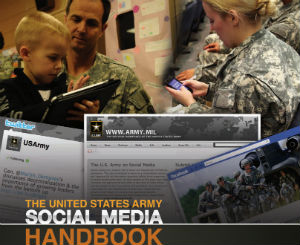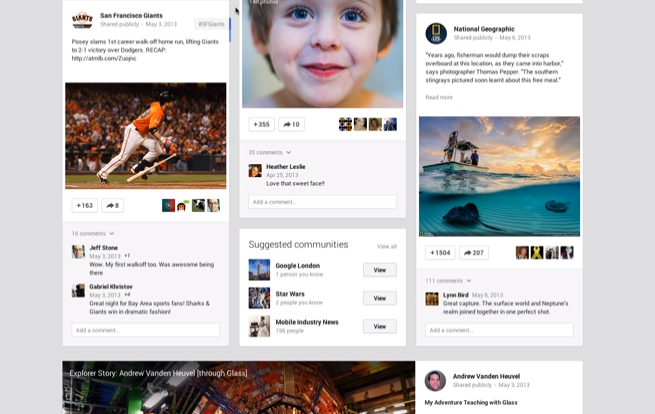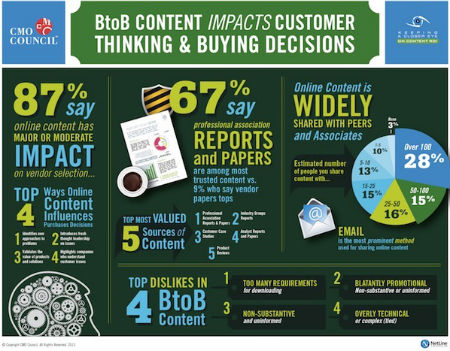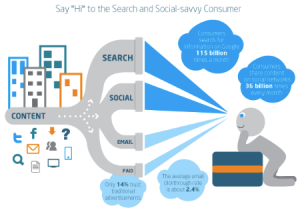|
20 Plus Tips on How to Optimize Your Presentations & Public Speaking
 | What does it mean to “optimize” your presentations? Keywords in your speech? Including your Twitter handle on all slides? Repurposing the slide content through Slideshare, Flickr, Visual.ly and on blogs? The answer is yes – all of the above. And more.
More marketing and communications pros are getting on board with the idea that public speaking is fuel for content marketing. The problem is, the focus on creation and promotion centers around individual content objects or presentations.
An optimized presentation strategy means having a narrative or story that includes your brand’s key messages and how the live presentation is connected to other content objects.
A live presentation can be connected to other content objects like a research report which might be connected to a series of blog posts which are connected to individual digital assets like images, polls, influencer interviews, infographics, press releases, podcasts and so on. You get the idea.
Wherever it is that your audience is looking for the answers you are qualified to give, presentation content can help you be the “best answer”.
Optimizing your speaking skills or your presentations is a worthwhile endeavor. Think of all the hours that go into researching, creating and preparing for a presentation that lasts only 15-45 minutes. Plus there’s the time it takes to pitch and the time to promote. It seems a waste not to make sure a presentation is a great experience for all involved.
I’ve given my share of presentations over the past 8 years and have gone from “nervous out of my mind” and blank audience stares to being asked to keynote conferences and paid speaking engagements at Fortune 1,000 companies. Besides those personal benefits, optimized speaking and presentations have been the most efficient, high impact content marketing we’ve ever experienced with our 13 year old agency.
While this post is focused on optimizing presentation reach and performance, the most important lesson is stop selling yourself or your brand, and sell useful information that connects with the audience emotionally and intellectually. Keywords and social media don’t make a great presentation. You do. Once you have a great story, optimization will help elevate the performance of that story and connect with people that are interested.
I know there are many, many subject matter experts and executives at companies that could benefit from optimizing their presentations. Here are a few tips:
Key questions for optimizing public speaking as a content marketing tactic:
1. How does the presentation fit your overall marketing or messaging objective? How does it further your goals?
2. What is the objective of the presentation itself?
3. What is the objective of the audience that will be exposed to the presentation?
4. What is the story? What is the hook? What is the creative angle, metaphor of aesthetic?
(And does that tie back to your overall brand or messaging?)
5. How do you want people to feel after experiencing the presentation? What 2 or 3 key concepts should they associate with you and your brand?
Answering these questions should help you define your approach and how the presentation connects with both brand and audience objectives.
If a presentation isn’t a win for the audience, it isn’t a win for anyone.
The best investment of your time with presentations is in the planning. Make sure your story is solid before you start hunting for clever full screen images and fonts to use.
The style of presentation should match your objectives. Inspirational presentations should connect emotionally with the audience. Instructional presentations need to provide practical, easy to understand examples. No matter what type of presentation you give, it needs to be entertaining or you’ll never connect and keep audience attention.
Presentation Deck Optimization Tips:
Here are a few of the steps I follow when creating optimized presentation decks to improve the presentation experience during the event and boost the search and social exposure afterwards.
- Create a presentation template that includes a linkable logo, twitter handle and hashtag as appropriate at bottom middle or bottom top. At minimum, include a twitter handle.
- Write a creative title for the presentation. Also write a keyword optimized title for use with a blog post.
- Create a structured outline of the entire presentation
- Write a paragraph summary of the presentation. One that is 12 – 25 words, and one that is about 50 words long. Focus on what the viewer will get out of the presentation most. Use these with meta description fields, on Slideshare and as an annotation to the embedded presentation in a blog post.
- Make a list of “tags” or keywords that represent key concepts. You’ll use these when promoting the deck online.
- Write (tell) the story of your presentation in text like a script. This guides your flow and can be repurposed as blog content before/after the event.
- Add images or examples that support the idea of each slide. When it comes to text, KISS. Keep it super simple.
- Write optimized headlines for each slide (whether viewable or not). This shows up on Slideshare and aids findability.
- Cite sources (statistics, quotes, images) Organize these efficiently and you can more easily use them in an infographic later.
- Write short descriptions for each slide using the outline and story – put them in the notes of the PPT deck. This will be useful when reposting the deck to Slideshare and related sites. It also reminds you what you’re going to say on that slide.
- Include “Tweetable” quotes, statistics throughout the presentation. Check them for length to ensure they are Twitter friendly.
- Link images to related content on your blog or website. Not useful during the presentation, but plenty useful to viewers online afterwards.
- Include short URLs in the slides where appropriate for downloads, resources and more information.
- Identify the images, statistics, quotes and other elements within your presentation and how they can be repurposed in other media and on the social web.
- Upload your presentation online before or immediately after you give it. Make it available to all attendees or broadcast a short URL to your networks if you want everyone to see it
Optimization Tips for During the Presentation
I’ll finish this post with a few optimization tips for use right before and during the presentation. Employing these tactics can help you better engage the audience that is present as well as extend the reach of your message to their networks during and long after you’ve left the room.
- Promote the presentation in a way that creates anticipation. For example: Ask a compelling question and post it as a tip on Foursquare for the event. Do the same on Twitter and to the event Facebook and LinkedIn groups.
- Schedule tweets of your statistics and quotes to publish during your presentation using the conference or event hashtag.
- Use graphics and concepts from the presentation in a blog post or guest blog posts to promote the presentation.
- Ask 1-2 qualifying questions with the audience to empathize with them – show them you are prepared to give material relevant to them – not just share what your brand wants to sell. Then actually act on the answers they give you – adjust your focus.
- Create incentives for social sharing. I like to give away a book for the best livetweeting or for liveblogging my presentations. Last time I spoke, I gave away a copy of Optimize and a box of Voodoo doughnuts. There were over 275 tweets in 45 minutes.
- Schedule a tweet sharing the URL of your presentation at the end for viewing later or download – Slideshare is awesome for this.
- Offer a slide of tweetable takwaways at the end of your presentation. Make it easy for them to remember (and share) your key concepts.
- Offer a link to something that provides next steps – a guide, report, whitepaper, video etc. Also the presentation you put up on Slideshare can include more than what you present live. To see that bonus content, viewers are given the option to provide their contact information.
Events offer many benefits for content marketing and networking. Here are a few other resources that cover optimizing your conference experience as a speaker, moderator and attendee.
What are some of your tips for optimizing presentations and content? What creative ways have you discovered to extend the value of your presentation investment?
|
Why SEO is Relevant When It Comes to B2B Thought Leadership
 | I’ll start this post off with my point: Dismissing search is ignoring demand from buyers & the media.
A digital marketing exec I follow on Twitter shared a CMI article that posted this weekend: “Why SEO May Be Irrelevant When It Comes to B2B Thought Leadership”. As a long time realist about the role of search in online marketing, I wasn’t sure if this was simply linkbait or a well reasoned, data-informed argument.
It’s a cliche to respond to “SEO is dead” articles because those writers are almost always uninformed or have an agenda unrelated to optimization. However, this post was on CMI, a highly respected site.
The article does offer some great tips on building thought leadership including advice on academic and professional journal publishing, publishing on client-facing media outlets and public speaking opportunities.
After that, it gets interesting starting with this logic: “getting found online is not an important objective in large, strategic B2B sales. And then, “the GTAA president's job depends, in part, on knowing how to find an answer to the question”.
Ironically, the article is about building thought leadership and credibility. Unfortunately contradictions like the one above doesn’t help the author’s credibility.
The author’s point: “…it's not about "getting found." It's about "looking good" and "looking credible" to clients that are assessing the expertise of potential service providers.”
I understand the value of creating great content relevant to the context of a particular buying experience. But how can you “look good” if no one involved in the buying cycle (or the media for that matter) can find you?
Even in niche B2B scenarios like a category mentioned in the article, “remediation of contaminated soil”, has an audience using search to find information that can benefit companies and thought leaders in that industry.
For example, search Google for “remediation of contaminated soil” and there are over 1 billion search results. The first page is a cornucopia of useful information from scholarly articles to videos to industry press. At the top are companies in the business of providing soil remediation services.
If search visibility is in no way important to establishing credibility with niche B2B industries, then no one would be searching, right?
A quick check of Google’s Keyword tool shows demand for hundreds of variations on “soil remediation and testing” for queries at different stages of the buying cycle:
- soil testing 110,000
- what is soil remediation 14,800
- soil testing companies 1,000
- soil remediation companies 200
Even using simple data to identify search demand for niche topics seems a more reliable decision making process than dismissing a tactic out of hand based on – a contradiction.
Another consideration is the effect of search visibility for members of the media doing research. Discovery of subject matter experts and story sources via search is a daily occurrence.
“I begin every day at search engine. It doesn't matter what story I'm working on, it always starts with a search.” Jason DeRusha, WCCO (CBS) TV News Reporter
Inclusion in industry trade publications is highly credible as suggested by the author in their suggested tips for building thought leadership. Why not make it easy for the media, peers and even bloggers to find thought leadership content? The credibility of being “the best answer” is priceless – especially in combination with visibility in industry publications and public speaking.
In fact, many B2B buyers will read thought leader content in trade publications and then Google people, companies and topics to drill down. Optimized content can play a role in all aspects of where and how niche B2B content is discovered.
Search connects people with information at the moment they need it most. Deciding to ignore that seems perilous.
The article did have some good advice on building thought leadership for niche B2B markets, but why invest in thought leadership content and then dismiss making that content easy to find?
Gain a competitive advantage by subscribing to the
TopRank® Online Marketing Newsletter.
© Online Marketing Blog, 2013. | Why SEO is Relevant When It Comes to B2B Thought Leadership | http://www.toprankblog.com
|
Read More »

Online Marketing News: 7 Social Media Sins, Matt Cutts Warns on Links, Rise of Vine
 | Gluttony, sloth, greed, wrath, lust, envy and pride. Most of us know that committing these sins is wrong. The rest of us were terrified into acknowledging that committing these sins is wrong by Kevin Spacey years ago. So if we know that something is wrong in the real world, why do so many continue to follow the path of the wicked online? Start your Friday off on the path of the righteous by avoiding these seven deadly social media marketing sins, as preached by XPLAIN.
In Other Online Marketing News…
Warning From Matt Cutts: Paid Advertorial Links Are Still Paid Links
Advertorial links, dressed up pretty to look like content, are appearing in greater frequency throughout the web. But just because it feels like content and looks like content, doesn’t mean it smells like content. And if you are considering this tactic, ensure you heed the warning of Matt Cutts in this new video, and avoid the risk of emitting a foul odor to the bots. ClickZ
Twitter Releases Vine For Android Smartphones As It Tops 13M Users
If you are an Android user, and have a short attention span, you are in luck! Correlating with an impressive rise to 13 million users, comes the Vine for Android app. Check it out now. TechCrunch
Google+ Trumps Twitter, Earning Second Place for Total US Social Networkers
Don’t let any lingering perceptions of a lackluster start paint you the fool. Among both women and men, Google+ has leapt into second place in a list encompassing all US social account holders. eMarketer
Study: 76% Of Executives Believe CEOs Should Be Utilizing Social Media Channels
And when we get this number to 100%, we will truly see a business landscape marked by unprecedented success. Marketing Land
Study: 85 percent of US Tweens Are On Facebook Without Any Supervision
And when we get this number back down to 50%, we will see a parenting landscape marked by unprecedented sighs of relief. NBC News
Solving Mystery of Mobile Safari Traffic – Ironically – Does Not Lead To Solution
For months, online publishers have seen mobile Safari traffic coming into their site as direct referrals. Are you shocked to find out that it’s something as simple as a meta referrer tag? Are you equally disappointed to learn that knowing this, unfortunately, does not result in you seeing this traffic? Search Engine Land
Salesforce To Acquire ExactTarget for $2.5 Billion
By far, Salesforce’s biggest acquisition to date. All Things D
Are Content Curators The New Editors?
The question is intriguing. This article is absolutely compelling. EContent Magazine
Google AdWords Enhanced With Image Extensions
PPC visual results are expanding beyond simply product ads with the beta for Image Extensions in AdWords. Search Engine Land
[Infographic] How Companies Organize For Content Marketing Success
Content marketing is the go-to marketing priority for 2013. See how this plots out in terms of tasks and ownership. Content Marketing Institute via Visual.ly
TopRank In The News
No trip to the beach this summer is complete without a pair of Ray-Bans, plenty of sunscreen, a frisbee – and of course – Optimize. Just this week, synthesio named Optimize to its 2013 Social Media Summer Reading List.
Need to power up your social media marketing efforts? Look no further than this post on Entrepreneur, summarizing 2013 Social Media Predictions, an eBook created by TopRank Online Marketing for Dell.
Now You Tell Us
What do you think is this week’s biggest story? Or better yet – how will the online marketing stories we’ve shared this week make you a better online marketer next week? Let’s talk below.
Gain a competitive advantage by subscribing to the
TopRank® Online Marketing Newsletter.
© Online Marketing Blog, 2013. | Online Marketing News: 7 Social Media Sins, Matt Cutts Warns on Links, Rise of Vine | http://www.toprankblog.com
|
Read More »

How Personas Guide Meaningful Content Creation & Optimization
 | As marketers accumulate information about customers, it is also important to identify common characteristics and patterns to help guide messaging, engagement and offers.
Behaviors that contribute to your business objectives like, sales, advocacy, sharing, referrals and repeat business might contribute to your understanding of an "ideal" customer that can be characterized as a persona:
Admin Bob – Influences the CEO on software purchases and cares about price, service and speed.
Being able to identify your “best” customers also means there's another end to the spectrum: patterns that reflect undesirable customer behaviors and an "avoid" persona:
Gatekeeper Jane – Maintains power by filtering information to the CEO about software purchases. Cares about control, recognition and status quo.
Companies that solve different problems in different markets may determine that multiple personas best represent their target audience.
Understanding the pain points, goals and topical preferences of your customers’ personas provides invaluable insight into planning content to guide that customer through the buying cycle. The motivations and context that bring a customer to search or tap into their social network for recommendations can then be translated into tactics.
How do you use personas in online marketing?
Content Planning – Based on the need, pain point or goal for your ideal customer persona, identify if content already exists to meet it. If sufficient content does not exist, incorporate it into the content plan for story creation . Map your customer needs like "How can I back up my computer without having to worry about losing disks or remembering to schedule?" to specific content like an article, how to video or even a product page that will help guide that persona along in the sales cycle.
SEO – Keywords in demand that represent the product or service relevant to the persona's need should be researched for popularity and competitiveness. Based on the back up example above, research more than the obvious "computer backup" to include phrases that describe situations or scenarios like "computer back up without disks" or "automatic computer back ups". Keyword optimize existing content and incorporate SEO copywriting into the task list for ongoing creation of content according to the content plan.
Social Media Presence & Engagement – In what social channels does the customer persona participate? Where are they influenced? Based on persona participation, determine if a brand presence exists at all. If so, does it share and engage with content related to the ideal customer persona's needs and goals? If not, factor that social content opportunity into the brand social media strategy for creating a social presence. What social topics is the persona motivated by? Do threads of discussion already exist in social channels relevant to the customer goals? How can your brand be an authoritative voice on those topics? Incorporate relevant social topics in your community management, social content and engagement approach relevant to the ideal customer persona.
In the assessment of existing web page and social assets, determine how well those search and social media assets perform in terms of ranking and social visibility. Reconcile the difference between current performance and the ideal in order to better attract, engage and inspire the target persona. Add new content, optimization and social engagement tasks accordingly. Also consider what metrics will help you identify whether efforts to connect with your ideal persona are successful or not.
A fragmented effort within search, social media and content marketing helps no one. Not customers and certainly not companies.
Competition for attention within search results and on the social web is only going to increase as more brands become publishers and more customers create and socially share content. The need to create a relevant experience for your target customers in an online world of information overload is more important now than ever.
Smart marketers would do well for themselves and the customers they're trying to reach by investing in the development of customer personas that reflect the desires, goals and key traits of their best customers. Translating customer insight into quality keyword optimization of web pages, social content and digital assets for specific phrases according to the searcher's needs in the buying cycle is an important step along with social engagement. As a result, you'll deliver a more relevant experience for both search engines and for customers that is worth sharing on the social web.
Next steps for leveraging customer personas in your digital marketing mix:
- What are the common characteristics of your best and worst customers?
- Collect information on common customer data points including: content preferences, search phrases, social networks, and the types of products or services they buy or "like".
- Based on your research and “best customer” characteristics, create and name an "ideal" customer persona
- Map the needs and goals of customer personas to your web and social content planning.
Are you leveraging customer segments, profiles and personas to inform your content planning? What about content optimization and social engagement?
Excerpt with permission from Optimize: How to Attract and Engage More Customers by Integrating SEO, Social Media and Content Marketing, published by Wiley. (Affiliate Link)
Gain a competitive advantage by subscribing to the
TopRank® Online Marketing Newsletter.
© Online Marketing Blog, 2013. | How Personas Guide Meaningful Content Creation & Optimization | http://www.toprankblog.com
|
Read More »

Content Promotion Tips for Online Community Managers
 | In a few weeks I’ll be giving a talk at the University of St Thomas in Minneapolis to a class on community management on a topic that I think will interest many of our readers.
Online Community Management is a function that has existed in the digital world for a while now, stretching back to the days of bulletin boards and online forums. Today that role looks a bit different.
Not be confused with a Social Media Manager, a Community Manager is typically the “voice of the brand” on the social web as well as the voice of the community back to the brand. Functionally, this translates to social media listening and engagement but also includes some promotion of brand messaging.
The growth and popularity of social media has exploded the audience and participation of public online communities, so the need for people skilled in the art and science of community management has also increased. Since some of the Community Manager responsibilities cross over into brand content promotion, that’s where this post is focused.
Key Considerations for Community Manager Content Promotion:
Topics – How does the brand want to be known? What is it already know for? What topics represent the value the brand delivers for customers and the broader community? When it comes to being the “best answer” for questions that the community has, what topics or even keywords describe those questions and answers?
Some of the topics can be determined by answering those questions and many more will be revealed during the course of working with the community. The starting point is, “What does your brand stand for?” and “What does your community care about?”. Those topics can be mapped to key objectives for the brand and how involvement with a social media or online community will help the brand reach those goals.
Content Sourcing – Guided by a list of topics that represent the goals of the brand and the community, content promotion sources can be identified and filtered. The Marketing people will be (or should be) feeding Community Managers with information on planned company marketing, PR and communications events. An over Content Marketing Plan and Calendar can do this pretty effectively.
From a tactical perspective, content sourcing for a Community Manger can involves a mix of content types, such as:
- Community Content Curation
- Industry Content Curation
- Brand Message Promotion
- Brand Content Curation
- Crowdsourcing Community Content
There are many sources to look for these types of content from using search engines (news, image, blog) to industry newsletters, to searching social networks for trending topics. The most basic and effective source of content is the community itself. Create a cycle of asking them questions, aggregating answers and recognizing their participation. Check out this post for multiple creative content sourcing ideas.
Editorial Calendar – Planning social content is a mix of pre-determined topics and content types as well as allowing for dynamic and spontaneous content based on events and opportunities. Here’s a blog content calendar template that includes:
- dates
- topics
- titles
- description
- target audience
- buying cycle
- keywords
- categories
- promotions
- repurposing
- media types
- internal citations
- 3rd party citations/sources
Hub and Spoke – For many companies, the most practical model for content and social media where a blog serves as the hub and social networks are the spokes. There are other models depending on the social media maturity level of the brand and community, but hub and spoke is an effective starting point.
Social Content Optimization – Search is priceless for connecting brand social content with people who are actively looking. For Community Managers, that means being provided with a keyword glossary from the SEO team. Keyword Glossaries are a tool to help you understand what phrases are high in demand. Armed with a list of keywords mapped to brand content and sorted by popularity, Community Managers can make word choices to improve attraction of search traffic without compromising the message.
Social Content Promotion – The best rule of thumb for social content promotion is to only share what’s worth sharing – whether it’s brand, community or industry content. When a marketing manager ask for some lame thing to be tweeted, plussed and posted to the Facebook Fan page – just say no. And explain what qualifies as “promotable” content that adds value to the community. Social content promotion can be a slippery slope and brands will only reap what they sow. Creating value first, empathizing with the community and being creative with brand promotion are all essential. Here’s a great post on promoting social content that also helps make it more findable.
Social Content Repurposing – On a daily basis, some social content like a Tweet might be reasonably repurposed for sharing on LinkedIn, Google+ and Facebook. Some might be duplicates. Some might be longer or more visual representations of the original. What will work for your community might not work for others, so test and observe.
A classic example of repurposing:
- Curate industry statistics
- Post one statistic every day or once a week to the corporate Twitter account, or LinkedIn, or on an image to Google+ or Facebook
- Leverage said statistics in the company newsletter, blog posts and in presentations
- Compile statistics into a blog post
- Create a PPT using dramatic images with the stats in a clever font – promote on Slideshare, embed on blog
- Create an infographic using these statistics – break the infographic down into PPT slides and share on Slideshare
- Create a video with statistics illustrated on top of B-roll video clips and promote on YouTube, embed on blog
- Conduct short interviews with industry thought leaders where their opinions on the curated statistics drives the questions – publish on blog
- And so on and so on…
It is not advisable to repurpose using all of these tactics, as the duplication would alienate your community. But this should give you some ideas on repurposing.
Monitoring & Measurement – Goals drive measurement and there are a variety of performance measures for building and engaging with a community. When it comes to social content promotion, quantitative measures of reach and qualitative measures of engagement are worth tracking at daily, weekly and longer term intervals. Short term tracking reveals opportunities and direct impact. Longer term tracking helps identify overall trends.
I’m going to stop here, because this was supposed to be a quick 500 word post and I see it’s now over 1,000!
I’ll leave you with a question though: To what degree should Community Managers be expected to promote brand social content?
Photo: Shutterstock
|
Social Media Hubs for Brands – Best Practices & 9 Examples
 | Social content curation and social content creation are often the core to many brands’ social networking efforts. Curating and sharing useful content associates the topics with the brand and creates an affinity for the brand as what I like to call, “the best answer” for their areas of focus.
Growing social participation is motivating many companies to aggregate content produced and curated by the brand’s own employees. This is a compelling opportunity to harvest the brand’s own collective wisdom. A single destination for curated social content fuels a brand publisher model that supports brand storytelling, content marketing, PR and even SEO objectives.
Additionally, curated and aggregated customer interactions with the brand on the social web can surface advocates and provide customers with a view of how the company is referenced on social networks. Third party endorsements, observations and interactions are the most powerful, so why not curate them into a social hub?
In 2009 I wrote about the now defunct Best Buy Connect social hub. Maybe the idea was ahead of its time, because today many companies are curating brand and customer social content as social media hubs. The growth of social media and the impact of Pinterest design has clearly influenced how many brands employ social hubs. Here are some examples worth studying:
Team Titleist – More than aggregated brand social content, this is a community powered by the Telligent platform. However, it does include social hub features by aggregating the brand’s social content from Titleist blogs, Twitter, Facebook and Instagram accounts. The default sort is by what’s trending. Users can make comments on blog posts and perform normal Twitter functions, and Facebook and Instagram offer offsite links. If you want to see all of Titleist social content aggregated in one place, this is it.
O-I Glass is Life – The Owens Illinois social hub is very robust and powered by the Postano Hub platform, which is incredibly fast. Aggregated social networks include Facebook, Instagram, Pinterest, Tumblr, Twitter, YouTube and Vimeo. Curation is focused on brand published social content on each of these platforms and users can interact and share on any of the aggregated social content, which is a social media optimization best practice.
Intel IQ - Curated by Intel employees, IQ is powered by Intel’s own IQ social content curation platform with the purpose of showcasing the impact of technology on media, life and the planet. The site is broken down into 3 sections: Featured stories created or curated by Intel IQ staff, Top trending stories, each with an “IQ score” and Tweets that use the #IQ hashtag. All stories are “share enabled”.
White House - Social Hubs are no limited to the private sector and in fact, many government organizations use social hubs either as a static aggregation of all the various social media accounts for the institution or as more of a dynamic hub like you’d find in the other examples on this page. The White House social hub offers column formatted streams of social content from Twitter, Facebook, YouTube, Scribd, Flickr, Slideshare, Google+ and LinkedIn. Users can share Tweets and all other curated White House social content links to their respective platforms.
IBM Voices – Based on an internal social content aggregation platform called Voices, IBM’s social hub aggregates blog posts, Tweets, videos, and photos from an IBM Tumblr blog. There’s a word cloud representing trending topics and the normal sharing options for the Twitter feed items. All others either link offsite or open a pop-up window. There’s also an “embed” feature which is unique from most other social hubs.
USA Rugby Social Hub - This sports team social hub offers another Pinterest style layout with never ending scrolling down and a featured story at the top – front and center. Social content is aggregated from USA Rugby’s Twitter and Facebook accounts as well as from fans that use the #usarugby hashtag. Each story can be shared to Twitter. Otherwise, they link to their respective social platforms.
Dell IT Social Hub- Dell actually includes an explanation of what their social hub is for, which I found useful to understand intent: “A central place to find, share, and comment on all our most current social tidbits and current events from Dell's public sector and large enterprise segments”.
Social content is aggregated from Dell social accounts at Facebook, Twitter, YouTube, SlideShare, StumbleUpon, Delicious (old school!), Digg, Dell Blogs and Community. Users can view content from all or just specific social channels. Content is further segmented by category (Enterprise, Healthcare, Education, etc) and each item can be shared to other social networks via the ShareThis widget.
Nine West Social 9 - Powered by Postano Hub, this social hub with a never ending scroll, aggregates brand social content from Facebook, Twitter, Pinterest, Twitter, Instagram and Google+. Each item is sharable to other social networks.
Social@Cisco - Tech companies were early to the social hub space and this hub from Cisco shows the column format used by many of those early adopters. Cisco content from blogs, communities, YouTube, Facebook, Google+ and Twitter are curated here. Sharing at the story level is not enabled but each does link back to the platform where it originated or in the case of videos, opens a pop-up window.
Some of the social media hub tools used be these brands and others include:
For companies using blog or CMS platforms like WordPress, there are plugins that can be used to create similar effects as illustrated by the brand social hubs above. The social hub for our new TopRank Online Marketing website is a good example of this:
If your company has either:
1. An active social presence on multiple social networks and media sites
2. An active consumer or buyer fan base on the social web that frequently mentions your company
Then it makes sense to create a social hub. Start small with just a few sources, such as blog, Twitter and Facebook. Then add as your community grows.
Which brand social media hubs would you add to this list? What social hub curation and publishing platforms would you add?
|
Online Marketing News: Google Blimps, Social CEOs, WordPress Turns 10, Future of Internet 2.4 Billion Strong
 | With over 850,000 views on Slideshare in just 2 days, this 2013 Internet Trends report from Mary Meeker & Liang Wu from KPCB is a must read. There are over 2.4 billion internet users world-wide and huge opportunities in store. This report speaks to the state of content (including photos, video and audio) and how it is increasingly findable, shared and tagged. Digital content is created and shared 9 times more now than 5 years ago. Mobile use is expanding at a dramatic rate and implications for smartphones, tablets and even wearable devices are explored.
In Other Online Marketing News…
Google blimps will bring the web to Africa. Search giant Google is intending to build huge wireless networks across Africa and Asia, using high-altitude balloons and blimps. The company is intending to finance, build and help operate networks from sub-Saharan Africa to Southeast Asia, with the aim of connecting around a billion people to the web. Wired UK.
The Social Imperative for CEOs. A new study from KRC Research has found that 76% of executives think it is a good idea for CEOs to be social. The benefits of the Chief Social Evangelist role has many benefits ranging from boosting company reputation to impacting business performance. (Inlcudes a report, video and infographic). Weber Shandwick.
WordPress Turns 10. WordPress founder Matt Mullenweg reflected on the 10th birthday of his baby that now powers over 70 million websites and WordPress has grown to be the largest CMS in the world, powering an astounding 18% of the web. Happy Birthday WordPress! Mashable, WordPress.
Consumers Want A Mobile-Optimized Web. A survey by Kentico Digital reports that 85% of smartphone owners use their phones to compare info before making a purchase. 75% of smartphone and tablet owners say the look and feel of a company's mobile Web site plays into their purchase decision. When it comes to Web sites that aren't mobile-optimized, 44% of tablet and smartphone users said they'll never return to the site. MediaPost.
Twitter bumps lists from 20 to 1,000. Each of those 1,000 accounts can have up to 5,000 Twitter accounts listed. The Next Web.
Google’s Impressive “Conversational Search” Goes Live On Chrome. According to Danny Sullivan, the conversational search feature demonstrated at the Google I/O conference has natural language, semantic search and more built into it. Search Engine Land.
Only 37% of Marketers Think Their Facebook Advertising Is Effective. Citing the recent 2013 Social Media Marketing Industry Report from Social Media Examiner, 92% of marketers surveyed use Facebook in their marketing mix, but less than 40% are satisfied. ClickZ.
Under pressure, Facebook targets sexist hate speech. Under mounting pressure from activists and advertisers, Facebook is ramping up efforts to stamp out hate speech, particularly depictions of violence against women. The move, announced Tuesday, came after a weeklong campaign by women’s groups targeting pages that celebrated or made light of rape, domestic violence and sexual degradation of women. CNN.
Gmail Updates the Inbox with Tabs. Tabs will appear at the top of the Gmail inbox where users can select personalized categories like Social, Promotions, Updates, and Primary. The new inbox is rolling out gradually. The desktop, Android and iOS versions will become available within the next few weeks. Official Gmail Blog.
TopRank Community Comments
Yesterday’s The Truth About Content Marketing & SEO post struck a chord amongst some impressively credible marketers, who took the time to respond:
Robert Rose says: ”Here here…. Excellent post…. This is a constant battle these days as SEO remains so important, yet is changing so fundamentally. As I often tell clients – you can be a content production factory – and your content will do nothing but settle bar bets. Or, you can be remarkable, and perhaps reach fewer people. And as you point out, it’s not a zero sum game – and it’s the balanced approach that will ultimately win. Kudos my friend.”
Bernie Borges says: “Well said Lee….The truth is (as you say) that as content marketing has become mainstream, some brands are flying by the seat of their pants without regard for best practices. If they experience poor results, they’re the first ones to say, it doesn’t work.”
John Ellis says: “One of the biggest myths propagated by the SEO world's definition of content marketing is that it simply means creating more content. Great statement +Lee Odden. Content without SEO is a waste. More content with out purpose or intent is also a waste. Extremes are typical in this industry. Go after the latest shiny object seo tactic without applying any actual SEO with the tactic. SEO is not a tool, not software, not marketing. It is a process.. plain and simple. A process that is applied to everything we do on the web. The skill that most do not understand is the natural application of the SEO process to our content and engagement around that content. Content Marketing is not a "subset" of SEO either. No it is not. Great article.”
TopRank in the News
Optimize was named one of the “5 Must Read Marketing Books for Small Business” by Intuit along with Content Rules by my friends Ann Handley and C.C. Chapman and The Rules of PR and Marketing by David Meermand Scott. Optimize is in great company!
My long time pal John Jantsch did a podcast interview with me on The Future of SEO (plus a good bit on what content marketing really means) over at the Duct Tape Marketing Podcast.
|
The Truth About Content Marketing & SEO
 | Over the past few years, there’s been a tremendous focus on content creation in the search and overall digital marketing world. Once you get past the hype, there are plenty of well documented case studies showing the ROI of a content marketing approach.
Unfortunately, content marketing campaigns are often guilty of paying little more than cursory attention to the optimization of digital assets for search. There might be a “keywords” or “SEO” check box on a task list, but it’s not anything that takes full advantage of search based discovery. The content might be engaging and inspire action, but good luck finding it on a search engine.
Why is this? It can be a mix of factors ranging from the ambiguity of SEO cause and effect to prioritizing tactics according to the ability to implement and understand how to measure their impact.
The flip side is when SEO and popular keywords drive the entirety of a content creation effort. When the focus is on aligning all assets and tactics for attracting buyers via search – it can be at the expense of content quality and the customer experience.
This debate is not new at all:
What good is great content if no one can find it? How useful is findable content when it doesn’t engage and persuade?
For whatever reason, many marketers tend to gravitate towards extremes: “All SEO All the Time” or “Content: More, More, More”. One of the biggest myths propagated by the SEO world’s definition of content marketing is that it simply means creating more content. This flawed approach has gained momentum due to hyper-promotion by SEO consultants trying to differentiate themselves. Attention and budget are being taken away from core SEO programs, creating more than a little hostility towards the “more” definition of content marketing.
The thing is, most Digital Marketers do not see content marketing as simply creating more content.
Here’s my definition: Content Marketing is the thoughtful creation of content designed for a specific audience to inspire a particular outcome. It is often mapped to the information needs of a target audience segment during the customer journey from Awareness, to Purchase to Advocacy.
Content Marketing is infinitely more than just creating more blog posts, videos and infographics. Content Marketing is not a “subset” of SEO either. A strategic approach integrates content marketing and SEO as appropriate to the audience and objectives, not according to the capabilities of the agency.
For brand marketers that are tasked with month over month increases in web sourced customer acquisition and revenue, prioritization of resources is the reality. It’s not just about the tactics, but about the things that can actually be implemented and move the needle.
Content Marketing Strategy has to factor in all digital channels as well as offline where appropriate because the focus isn’t solely on a search engine. It’s on the customer. Customers don’t just use search for finding solutions. Search is hugely important during the customer journey, of course. But it’s not the only touchpoint.
The only thing worse than no SEO at all, is ALL SEO.
Ignoring the contribution of search for attracting visitors that are actively looking for your information is a huge mistake. At the same time, ignoring content marketing simply defined as “more content” and focusing only on SEO is also a mistake. Search engines don’t buy products, people do. Market to the people!
There’s no arguing that Search Engine Optimization can be a specialist’s game, especially when dealing with technical SEO or issues related to having been delisted and requiring link cleanup and re-inclusion work. Speaking of which, there is no better indictment of the SEO industry and its reputation than having to pay a SEO agency to clean up the consequences of previous SEO work – especially when Google has been pretty clear about webspam and SEO tactics that violate Google guidelines.
I’d like to think those times are past us and that modern SEO is more aligned with a holistic approach to digital marketing than risky shortcuts.
More content isn’t better unless it’s meaningful and findable.
Most companies have minimal content creation in their marketing mix, so creating more content will always be a part of improving their online marketing. SEO can play an important role in content marketing strategy by informing topics, content organization, message and promotion to achieve the findability objective. Of course the broader notion of optimization means furthering the goal to conversions as well – i.e. the performance of the content as a marketing asset.
As competitive and dynamic as the web is today, I can’t imagine how anything but a collaborative and integrated approach to content marketing and search engine optimization can win. That’s the truth.
Image: Shutterstock
|
B2B Content Marketing Tactics: Pros, Cons & Best Practices of Case Studies
 | Within the realm of B2B marketing, it’s stories, not “features and benefits” that allow brands to create relevant and engaging connections with prospective customers. Successful digital marketers use a variety of content marketing tactics to tell stories according to the goals of both brand and customer.
Even though 71% of B2B content marketers use case studies, they are often an under optimized form of brand storytelling. Case studies provide a structured problem and solution format that provide context, situation and challenges that the reader can empathize with. Case studies also supply insight into how a problem was solved, paving the way for the solution and measures of success.
As part of our ongoing series on content marketing tactics, this post will share some examples and best practices of organizations leveraging case studies as part of their content marketing mix.
Definition of Case Study:
A”case study” in the context of marketing is an analysis of a project, campaign or company that identifies a situation, recommended solutions, implementation actions and identification of those factors that contributed to failure or success.
Pros & Cons of Case Studies as a Content Marketing Tactic:
Pros
- Provides a structured problem and solution format, often including practical insights the reader can apply immediately to their own situation
- Demonstrates the solution provider’s approach to problem solving: methodical, creative, out of the box, disruptive
- In aggregate, a collection of case studies paints a picture of where the organization excels and what expertise differentiates them from competitors
- Keyword optimized case studies can serve as a direct point of entry via search to specific solutions the customer is looking for – shortens sales cycle considerably
- Case study content can be multi-purposed in text, image, video and document types: web page, PDF, Word, PPT, Slideshare. Case studies can serve a role in eBooks, white papers, guides & best practices, webinars and conference presentations.
Cons
- Case Study content can become outdated and needs to be maintained
- Required approval from parties involved can be difficult – not all companies want to explain how their marketing is successful
- Over duplication or repurposing of case study content can affect search visibility if not properly optimized (canonicalization and links)
- Boring or underwhelming performance cited in case studies can do a better job of turning prospects away than engaging them. Invest in great writing.
What Marketing Experts Say About Case Studies:
“Most case studies are focused on the solution and how great it is to the exclusion of any real "story." To be effective, case studies need that middle part where the magic happens. Case studies need a beginning, middle and end focused on the customer's perspective – just like all other content. I advocate for two versions; a 1 pager with the facts for a quick read and a longer "story" version that helps prospects visualize themselves solving the problem.” Ardath Albee, CEO Marketing Interactions, Author.
“Case studies can be a wonderful piece of a B2B marketer’s content marketing strategy except that most of these marketers make the mistake and use it to beat their chests like Tarzan. They have to remember: it isn’t about them, their product or their service. It’s about their customer, their problems and how they got solved.” Bryan Eisenberg, Best Selling Author, Keynote Speaker and Consultant.
“Customer case studies in all formats are impactful for both B2B and B2C marketers as a way to tap into the significant power of peer-generated reviews and recommendations. My first choice is shorter, video formats b/c you can use photos, faces voice, movement to convey a proven, real third party endorsement.” Sandra Zoratti, VP Global Marketing at Ricoh, Author.
Case studies are just stories. Too often these days, they’re presented in a formulaic manner, but when thought of as stories, they can be powerful. B2B marketers talk to each other. In fact, more B2B purchasers start their research online than B2C — with peers representing one of their most important resources. As long as it’s relevant and compelling, a story that conveys a solution to a problem in human terms should make for an effective piece of content. Shel Holtz, ABC, Principal of HC+T, Co-Host of For Immediate Release and Author.
Case studies can be a remarkably effective content tool. They seem to be most commonly used deeper in the funnel as a “proof point” or “testimonial” for the B2B sale. But they can also be a great awareness builder and credibility builder for the brand as well. One of the biggest mistakes I see companies making is that B2B marketers assume that they must get a product endorsement in order for a case study to be effective. But I’ve found that a quality interview (or story) of a customer, that makes no mention of your product or service at all — yet highlights the client’s expertise or success — can be a remarkably successful content marketing approach. It’s often the most effective way to get a client that isn’t allowed to give an endorsement to actually speak. The sheer fact that their story appears on YOUR site is almost always all you need to generate value. Robert Rose, Chief Strategist at Content Marketing Institute, Author.
How Are Case Studies Used in B2B Content Marketing?
When you search the phrase “case studies” plus terms that define your industry or situation, there are a wide variety of examples available. A good example is the Killer Content Awards deck embed in this post. Here are a few specific examples of companies successfully using case studies in their content marketing efforts.
MarketingSherpa does a great job of providing details in each of their marketing case studies, which you can find in their Library of resources. As a long time publisher of best practices, industry news and reports, expectations are high with MarketingSherpa. Just visit the Library section of their site and check the “case studies” filter in the left sidebar. Select any other refinements and you’ll get a list of case study articles. Each is written by a professional journalist and includes: Summary, Challenge, Campaign (with specific steps), Results and Creative Samples. The source is always cited as are related resources. What these case studies might lack in terms of visual fanfare, they more than make up for in terms of depth and insight.
Google Think Insights site contains an impressive collection of resources including case studies. As you can imagine, the search function is impressive but there are also a variety of ways to filter based on: Industry, Marketing Objective, Ad Type, Technology, Audience, Region and Type of Content you want to view.
Each case study follows a format of Goals, Approach, Results and may include a PDF download, creative assets or a video of the success story. Related case studies and content are also recommended. Obviously Google has substantial resources to create nearly 700 case studies, but there are lessons to be learned from the case study content and how users find that content. Navigation is based on user self segmentation vs. a simple link to “Case Studies”. This approach gives Google some context to provide more relevant case study content. In terms of the case study content, the combination of summary, web page, PDF and video provides different users with format options to choose from.
HubSpot is another example of a company that has collected a large number of customer stories and case studies. The previews for each case study include summary, bullets, a photo of of the customer with a testimonial, and clickable keyword tags. The actual case study pages vary quite a bit and do not follow a common template. But they do provide problem, solution, performance information. What HubSpot does really well is the ease of navigation, the summaries and calls to action. They are ready to do business.
Pinterest, as you can imagine, provides a more visual experience with their success stories. There are just a handful of case studies, which is something I think a lot of mid market or new companies can relate to. When you don’t have hundreds of case studies, then be sure to make the most of what you’ve got. With so few case studies, there is no categorization but that’s something Pinterest will want to consider as they add more. Each case study page includes stated Goals, and an endorsement/photo from the client. Most importantly, tactics, implementation and results information is provided in a story format using conversational language.
Mini How-To for Creating Great Case Studies:
Stories connect with us emotionally and people act based on emotions. However, they justify those decisions with logic. Effective case studies are stories that connect with the reader on an emotional level and at the same time, provide intellectual justification – data. Here are some key elements of a persuasive case study:
- Headline: Who, What, & Results – 10 to 15 words.
- Visual: Skip the stock photos and opt for images of real people when appropriate. Company logos and screen shots of results/performance information are handy as are any compelling visual elements that complement the story.
- Challenge: Start with the current situation. What is the trouble? Create friction and a sense of urgency that this problem needs to be solved.
- Solution: How does solving this problem create a positive business impact? What role did your brand play in the solution? Offer justification for the recommendations through the approach and tactics.
- Results: Create points of comparison. Contrast “the trouble” with the solution. Provide KPIs & outcomes. Use raw data points, percentages and general quantifiables as appropriate. Results must be compelling, remarkable, impressive! Align those results with your brand and offer future direction. Include a quote or testimonial from the key person involved with the project. How did this help them and what has this success done for the business?
- Close it: Near or alongside the case study, include a call to action appropriate to the case study. Don’t leave the CTA to your website’s “contact us” link or button in the navigation.
- Media: In the B2B world, a PDF file is expected. Be sure to offer the case study as a web page and in PDF format at a minimum. But don’t overlook posting to services like Slideshare or repurposing for use in articles, reports, webinars or conference presentations.
What’s your opinion on case studies? Are they tool uncool for B2B marketing school? If you’ve been successful with case studies, what’s your secret sauce?
Image: Shutterstock
|
Social Media and The U.S. Military – 3 Lessons for Business
 |
U. S. Army Social Media Handbook
Today is Memorial Day in the U.S., a day to remember all the men and women who died serving in the U.S. Armed Forces: Army, Navy, Air Force, Coast Guard and Marines. While much of the workforce in the U.S. takes today as a holiday and marks it as the start of Summer, it’s important to honor the sacrifices made by these brave individuals in service of our country.
Stories of remembrance during Memorial Day are often told through traditional news media covering parades or honoring the heroic actions of individuals and units. Social Media also plays a big role in military communications.
If you thought creating a social media policy and governance over employee social media activities is tricky, imaging the task of doing so in a military environment. It takes a lot more than a “Loose Lips Might Sink Ships” poster to communicate operational security for soldiers, units and other military organizations that maintain Facebook, Twitter and other social media profiles.
Remarkably, the U.S. military has made some significant accomplishments with its use of social media and in many ways, has lead the business community. One example of that was in 2008 with the U.S. Air Force publishing their guidelines for responding to blogs. I know at the time, one of the greatest fears companies had of social media revolved around the question, “What if people say bad things about our brand?” and not knowing what to do. That Air Force chart served as a guideline for many companies developing their social media policies.
I think there are other lessons to be learned by the business community from the U.S. Military and their social media efforts. Here are 3 of the most important.
Social Media Guidelines – Each branch of the service publishes and maintains a set of social media guidelines: Army, Air Force, Navy, Marines, Coast Guard. Probably one of the most important things military organizations can do in their effort to embrace the social web is to create guidelines about overall direction as well as specifics on what to do and not to do. Social Media Handbooks provide leadership and individuals with important guidance ranging from checklists and how to’s to FAQs and resources.
Lesson: While social media policies and guidelines have been around in the business community for a long time, many companies simply haven’t established them yet. Those that have, do not maintain them.
Whether you start with a basic social media policy tool, thoroughly research and create your own, or work with an experienced outside agency to help create one, it’s pretty important to do so. Then allocate the resources to maintain it in conjunction with your organization’s social media best practices used in marketing, PR, corporate communications, HR, legal and customer service.
Social Hub – Many branches maintain a repository of social media profiles and networks in a central location. Others, like the U.S. Army, and U.S. Air Force allow submission of social profiles for evaluation and inclusion in the hub. Aggregating social presence either as a list or by curating messaging (filtered of course) provides both internal (service members, families and other units looking for examples) and external audiences (recruits, news media) with a useful resource.
Lesson: Whether your company is small but with a big social footprint, or you have a large enterprise with numerous business units and branch operations, a social hub can provide a central location for internal staff and external audiences to find the right social resources within the organization.
Additionally, curating social messaging produced by your brand or talking about your brand can provide an interesting engagement opportunity for those curious about what people “really think” about your business.
Some good examples of social hubs that in the technology industry that curate brand messaging include: IBM Voices, Cisco, Dell, Intel.
Rich & Meaningful Media – As you can imagine, an all-volunteer military force requires a substantial recruiting effort. Social Media plays a critical part of communicating the stories and key messages of each branch to potential service members. Soldiers don’t get in the military for the money or because it’s a cush job. Each has his or her own reasons and the job of connecting with those diverse reasons is accomplished through images, video and engaging media that is designed for social media sharing.
Lesson: Companies need to understand the interests, needs and goals of those they wish to engage through the social web, whether it’s potential customers and employees, current customers and employees, news media, industry analysts, influencers and investors. When a business can create compelling stories that connect the interests of their target audience with the key messages of the brand, the results can be pretty impressive. As I like to say, facts tell but stories sell. What better medium to tell stories than video?
Video is hot for a reason. If a picture is worth a thousand words, a video must be worth millions. The magic of video isn’t just the format, it’s the message and the storytelling that matters. Companies would do well to investigate the role that a rich and meaningful media experience can play for attracting, engaging and persuading their target audience.
Without question, social media are a part of the life experience for every individual that participates on the web, whether working for a corporation or in the military. These are just a few examples of best practices worth considering as companies evolve from tactical experimentation to more strategic maturity of the social media operations.
What are some social media best practices you’ve seen in a military context that companies could learn from and use?
|
Online Marketing News: Biggr Flickr, Kmart Strikes Again, Yahoo Takes A Tumblr, Twitter Cards, Penguin 2 & SEO FUD
 | Kmart is at it again with a clever follow up to their highly popular video “Ship My Pants” that has had over 17 million views. The play on words this time is “Big Gas Savings” with over 1 million views in 2 days. Like the Old Spice videos that went ballistic, the question remains: They’re very creative and popular, but will these videos get shoppers in stores and buying at Kmart?
Flickr is Biggr. Users now get 1 terabyte of storage. I’ve been a pro Flickr user for many years and during Yahoo’s pre Marissa Mayer days, it had an uncertain future. Now Flickr is adding 1,000 x more storage for users and some new features including full resolution of images and new sharing functionality: “Upload once, send to any device, any screen, any friend, and any follower.”
The user interface has also been updated with the removal of small thumbnails and photos leading the experience, vs. text based navigation. I for one and looking forward to jumping back into using Flickr more often from the desktop, tablet and mobile. Via Flickr, Fast Company.
Arguably the big news in the SEO world this week was the roll out of Penguin 2.0, Google’s algorithmic webspam fighting effort. If your site is engaged in link buying, high volumes of exact match anchor text, or other link focused manipulations to improve search results, there’s a Penguin out to get you. More on Penguin from Matt Cutts, Search Engine Land, Search Engine Watch and of course, TopRank’s advice on Penguin 2.0 for Content Marketers.
Speaking of SEO and spam:
Google Notifies Sprint Of Spam Penalty; Seeks Advice In Google Help Forums. Apparently a portion of the Sprint site that was open for users to publish content was cited by Google for spamming. This is not a unique situation as Search Engine Land reports, since the BBC and Mozilla have had similar situations. Initially there was no help from Google outside of the notification but Matt Cutts eventually stepped in. As Barry notes in the SEL article, this is a tough one for brands to monitor, but they must if they expect to retain search positions and traffic form the almighty Google. Google Forum Thread. Thanks to Brian Larson for the heads up on this one.
Oh, How Pinteresting!, Introducing More Useful Pins for food, retail products, and movies. This week the nearly 50 million member strong Pinterest added a new feature directed towards commerce: Rich Pins. The new feature will make additional information available besides an image and description which many anticipate will give users more motivation to click through. Since Pinterest users tend to spend 70% more than buyers referred from non-social sites, there’s plenty of motivation for marketers to take advantage of these new features. Via Pinterest Blog, The Content Standard, Marketing Land.
Twitter announces ‘Lead Generation Cards’ to help brands drive qualified leads. Twitter has upped the ante for lead generation by adding 6 types of Twitter Cards as an advertising option for brands. Twitter cards (Summary, Large Image Summary, Photo, Gallery, App, Player and Product) make it possible for marketers to attach media experiences to Tweets that link to brand content. When someone expands your Tweet, they see a description of the offer and a call to action. Their name, @username, and email address are already pre-filled within the Card. Via Twitter Advertising Blog, TNW.
Yahoo has agreed to pay $1.1 billion for blogging platform and social network Tumblr, which is 6 years old and has 100 million blogs and about 300 million unique monthly visitors.What is Yahoo CEO Marissa Mayer getting for all that Yahoo cash? Cats, porn and a lot of opportunity to connect with a very attractive demographic. Via Wall Street Journal.
But wait, there’s more!
Yahoo continued the buying spree and purchased a startup that powers games played on smartphones, tablets, consoles or personal computers called PlayerScale for an undisclosed sum. Via TechCrunch.
In other news about the social web:
According to a new Piper Jaffray study, Teens’ interest in Facebook is dropping but their use of Twitter has grown by 50% in 1 Year. I suspect the growth of teens’ use of Instagram and Snapchat is also on the rise.
Nutella Thanks Its Biggest Fan, Founder of World Nutella Day, by Sending Her a Cease and Desist reports AdWeek. But according to ABC News, they then took it back. When legal acts without social media savvy, it can be a sharp sting that gets them on the right track.
From the TopRank Online Marketing Blog Community:
Empathize to Optimize Your Customer's Journey on the Search & Social Web – Carrie Morgan says: “A fantastic read on the same topic is Google’s Zero Moment of Truth, A must for every marketer to be familiar with! Nice post, Lee!! Great job story-telling. =)”
7 Steps to SEO at Scale, Patrick McFadden says: “Plan a Multi-Faceted Approach” Yes! The struggle many face with marketing online is a misguided impulse to put various tactics into separate boxes, instead of seeing each as an aspect of one strategic process.To this day, I see people referring to content marketing, social media marketing, and search engine optimization (SEO) as three different things — as if each is a tactic that can get you there alone. The smart way to treat these things as a holistic strategy.”
What are your thoughts on this week’s online marketing news? Was Tumblr a good call for Yahoo at 1.1 Billion? Do you like the new Flickr? How about Penguin 2.0 – is it doom and gloom or more like, “meh”.
|
In Search of Voodoo: Empathize to Optimize Your Customer's Journey on the Search & Social Web
 | I get to meet a lot of professionals in the marketing, advertising, communications and public relations industries where topics of conversation often revolve around content. Concerns about where to start, what tactics work best, how to plan, produce and promote all come into play right along with staffing, integration with other channels and measurement.
Of course, if you try hard enough you can worry yourself out of a job when it comes to developing a solid approach with content marketing.
On the one hand, there’s a temptation to spend a lot of time and resources developing “the perfect” strategy. On the other hand, you could also just start cranking out content and see what sticks.
Neither of those approaches really work well in a practical way. What does work? There’s one thing that can help answer many of the concerns marketers have about content and that also helps you cut to the chase for practical implementation: Understanding the customer journey.
Google Think Insights has a great post with tools to help marketers better understand how different content and channels affects customers during the buying cycle or customer journey to online purchase. Check it out and then come back.
Welcome back. Google has some of the best content marketing, don’t they?
There’s a saying that goes something like, “Walk a mile in a man’s shoes to really understand where he’s been” that reflects what a lot of companies don’t consider when creating their digital marketing plans.
Understanding the customer experience from awareness to consideration to purchase folds well into the core principle of Optimize – to empathize with your customer and understand how they discover, consume and act on information. By doing so, you can create a practical digital marketing plan that optimizes for attraction, engagement and conversion.
To put that idea of customer empathy in action, I put myself in the position of a customer and documented my journey from curious social browser to a highly motivated searcher.
I started on Facebook, asking my network (as many people do) for recommendations on things to do and see in Portland. Immediatley, Melodie Tao not only made several recommendations including Powell’s Bookstore, Voodoo Doughnuts and Portland City Grill, but she pointed me to a blog post where she had documented her visit to Portland. Pretty awesome right? I received many more suggestions from other friends too.
But is that all I needed to take action? Maybe for some people. But I needed more information, especially about Voodoo Doughnuts. So what do you do when a friend recommends something and you need to get more details? Where do you go to get more facts and information as well as to validate their recommendation?
Yes, that’s right. You Google it.
Lucky for me the search results for “vodoo doughnuts” reveals a cornucopia of useful information including reviews, local information, coverage in local and national press, the business website, map, address and even photos of the product.
That was enough for me. I knew I needed to include Voodoo Doughnuts in my presentation. If for nothing else, to experience the freak of sugary gastronomy that is known as a “Bacon Maple Bar“.
Arriving at the store didn’t disappoint and of course I had to take photos. And what do you do with those photos?
You use them when you check in on Foursquare.
Then share to Instagram and Pinterest of course.
The Takeaway:
Think about the ways in which your target audience discovers, consumes and acts on information so you can give them what they want. Optimizing for the customer journey means bringing in content, social media, search, advertising and even PR to help your brand become the best answer whether customers are asking their friends on Facebook or searching on Google.
It may not be practical to literally put yourself in your customers’ shoes, but maybe there’s an opportunity for a virtual “ride along” by talking to sales and business development staff or product marketing at your company. As much pressure as there is for ROI, don’t solely focus on optimizing for transactions, but optimize for experiences as well.
Is there a proactive effort at your company to map the customer journey? If you have multiple, distinct customer segments, do you identify the sales cycle for each group? What are some of your challenges and successes?
Photo: Shutterstock
|
7 Steps to SEO at Scale: How to Ramp Up Your Search Engine Optimization Strategy
 | comScore reports that in April 2013 there were over 20 billion search queries and of the 13 billion+ handled by Google, 16% of daily searches have never been seen before. Each of those attempts represents buyers looking for solutions at the moment of need. Online marketers that take advantage of modern, scalable search engine optimization best practices as part of their overall digital marketing mix can gain a significant advantage over competitors to become “the best answer” when it matters most.
Understanding the basics of search engine optimization can be challenging given how often major search engines update and change the rules. However, buyers’ overwhelming use of search to find solutions is too great to ignore its influence on the buying cycle and achieving sales growth goals.
Along with managing the implementation of current SEO best practices, marketers must also take advantage of SEO performance improvement opportunities. In competitive industries, these opportunities come up regularly and without warning. Organic search is very much a race to the top, in that one brand’s loss of positioning is another’s opportunity to move up the ranks.
Of course, ranking well for keywords that customers use when searching for solutions is useless to your business unless that positioning brings inquiries and conversions. The good news is, SEO best practices help achieve better positioning as well as the performance of those rankings. Business growth feeds the online marketing budget; brands dedicate more resources to online marketing tactics like SEO as they show growth in ROI. Marketers able to successfully manage SEO as part of the online marketing mix and demonstrate ROI can scale their SEO programs for even greater success.
But how do you do scale SEO? This post will outline 7 steps towards scaling up your search optimization strategy from benchmarks to conversions so you can create the framework for even more success with organic search.
Get Your Ducks in a Row
Planning for growth first requires an inventory of all existing assets, challenges, and opportunities. This insight helps drive a strategy based on a realistic understanding of where your business sits in the eyes of potential and existing customers – and in comparison to competitors. Some assets can be retooled, while you will realize other areas where new assets would be beneficial. Take stock of your situation and the variety of influencing factors, in order to begin planning from an informed and prepared place.
Make Your Business Case
Scalable SEO requires buy-in from company decision-makers, throughout planning and execution. You don’t need to know exactly what will happen and clearly, you don’t have a crystal ball. However, you should know enough of your business, industry, marketplace and opportunity to make educated projections based on a variety of scenarios and tactics you could employ.
A successful business case will clearly show decision-makers exactly how your proposed strategy and tactics will work and why they are necessary. Marketers need to take care to explain the opportunities (and detriment if action is not taken) in a way those outside of SEO will understand. Tie each facet of your SEO strategy to a business objective to win over those who will make or break your plans with their decisions. Most importantly, give them options. Don’t become married to one way of doing things, because there are always alternatives. Having more than one path in mind to your goal gives you the opportunity to refute rejections with alternate plans of action. It also helps decision-makers feel more involved and invested in the process when they are able to actually make decisions instead of being asked to sign off on the entire plan as a whole.
Have Resources at the Ready
If you’re handling your SEO strategy in-house, prepare training material and documentation to help new team members quickly get up to speed. Taking on new hires during growth can be challenging, as everyone involved is in learning mode.
If you are working with an agency, choose one from the start with the talent and resources to grow with your SEO needs. Remember that your SEO strategy is an investment; the cheapest option may not be the one that can scale with your growing company and its needs.
Plan a Multi-Faceted Approach
If you are responsible for the entire online marketing plan, SEO is just one of your considerations as the company grows and online marketing needs increase. If you are responsible for SEO only, you had better have a good working relationship with those who handle online advertising, public relations, social media and content marketing.
Sustainable growth requires that each component of your online marketing strategy work together. Assets from content marketing are critical to your search strategy. Social media is needed to build community, drive traffic and amplify your messaging. Email marketing can help close the leads earned through search. Integrating all aspects of your online marketing strategy brings a better ROI for each individual component and delivers a better, more personalized experience for customers.
Get Back to Basics and Best Practices
SEO changes rapidly, yet there are underlying best practices and basics that ensure your site and online presence is a good foundation for the actions you will take as your business grows. One client we worked with recently was able to increase their pageviews and conversion simply by getting back to basics, putting their customer journey first, and making on-site changes to bring them in line with SEO best practices.
Plan to Succeed and Avoid Playing Catch-up
At TopRank Online Marketing, we recently worked with a B2B online services provider looking for greater exposure of their company website in search where interested prospects were looking. They were looking to attract a very targeted subset of professionals to use their service and current SEO efforts were not effective. Though a strategic approach that included a series of SEO audits covering the content management system, content, keywords and both internal and externa links, a set of recommendations were made to optimize search visibility and performance of content in search. The result? Nearly 400% YoY increase in organic search traffic with a flat monthly investment. That’s the beauty of well planned SEO implemented over time: cost efficiency and a cumulative effect on performance.
Bringing on an online marketing agency to get their SEO strategy up to speed helped this B2B services company increase visibility where customers were looking when it mattered most. However, since the SEO strategy was not applied universally, the company did not benefit from substantial increases in search traffic for all parts of the business. By demonstrating the value of strategic SEO, TopRank was able to convince the B2B marketer to implement a cohesive optimization program based both on search engine visibility and unique content to answer prospect needs. As a result, the overall quality of traffic and the number of customers driven from search improved significantly. Imagine the results if their SEO strategy had kept pace!
Understand Your Customer Journey and Invest in CRO
If you want to be top of mind in a competitive industry, make your customers and their journey top of mind as you plan and execute your SEO strategy. Search engine optimization has to factor in what people will do, what action they will take, once they actually get to your site. CRO is the logical next step in any SEO plan, but also an important consideration in scalable SEO. Getting the right eyes on your site and helping them fulfill the need that brought them there needs to happen in tandem.
Clearly, preparation is vital to the success of an online marketing strategy that leverages SEO to better attract, engage and convert new business. We need to be able to plan, yet stay agile and able to quickly react to – or even anticipate – changing needs and opportunities based on changes within search engines and the customer dynamic.
What challenges or successes in scaling your SEO strategy to meet demand have you experienced?
|
Top 5 Social Media Questions Marketers Want Answered
 |
What if you could tap into the minds of 3,000 marketers to find out where they stand when it comes to social media marketing? How valuable would it be to know how your peers are handing the time commitments, social media platforms and measurement?
Lucky you and lucky me, the answers to those questions are found in today’s 2013 Social Media Marketing Industry Report from Michael Stelzner and Social Media Examiner.
A few of this year’s social media statistics:
- 86% of marketers say social media is important for their business
- 69% plan to increase their use of YouTube
- 58% of marketers are blogging and 62% will increase blogging in 2013
- 49% picked Facebook as the single most important social network
- 89% of marketers state that increased exposure was the most important benefit of social media marketing
From the most popular forms of social media marketing to measurement, to integration with other digital marketing tactics, this year’s report offers answers and also asks more questions.
Those additional questions “Top 5 Social Media Questions Marketers Want Answered” are the topic of this post. Below you’ll find the percentage of responses for each pressing issue and my answers plus resources for further exploration.
1. What social tactics are most effective? – 90%
Of all the questions answered by this report, identifying the most effective social media marketing tactics was the most important to respondents. Facebook, Twitter, LinkedIn, Blogging and YouTube were the top 5 platforms used by marketers in the survey.
When answering this very important and popular question, there are a few important considerations. Don’t fall for a simple list of the most popular social media platforms since what works for another company may not work for yours. At the same time, don’t think that you have to conduct an exhaustive research project into which social platforms your customers are on before making any kind of social media marketing commitment.
The practical approach is to make sure you’ve clearly identified business goals and outcomes you can measure as a result of a successful social media effort. At the same time, think about your customers’ goals and how a social presence for your brand will help make them happen. Then make sure you have a hub, whether it’s a blog or a social aggregator for your brand. Your actual tactical mix should be driven by what kind of social content and experiences will connect customers with your brand.
After a basic review of social media monitoring for brand mentions and a look at your web analytics for social referring sites, stake your claim with the top 4-5 social networks regardless if you’re B2B or B2C: Facebook, Twitter, Google+, LinkedIn and either Pinterest or YouTube. You can cross post content from your blog and curated news on the web at large to the first 5.
Once you have a rhythm for curating useful news and sharing your own content to these major networks, you can collect REAL data relevant to YOUR company and decide where to optimize your social media presence with tactics.
By starting with the networks that include a mass audience customized by your initial insights from social media monitoring, web analytics and competitive research, you can shorten the time it takes to capture interaction data that is relevant and meaningful vs. the sweeping generalizations most often made about social media marketing channels.
2. What are the best ways to engage my audience with social media? – 88%
The next most popular social question to be answered for marketers is at the core of what being social as a brand means. How to engage with your audience?
Companies that are new to the social web or that are at early stages in their level of social media maturity often know the answer to this question but simply don’t have the confidence to make commitments.
Some of the most practical things companies can do to learn the best ways to engage with their community in order to achieve mutual goals for customers and the brand include:
- Profile your customers with analytics data, social media monitoring and direct surveys. Use that insight to find out the networks they spend time on and the topics that interest them.
- Review competitors social media activities to discover anything they’re doing that appears to be working as well as things that are not.
- Research and network with influencers in your industry. And not in a desperate “please can you share my tweet or blog post?” way, but in a meaningful way that adds value, “I noticed your question about XYZ, here’s a post on XYZ best practices you might find useful”.
- Monitor your community for advocates and recognize them! Nurture and support them, but don’t try to “buy them” with freebies etc.
- Seek out questions being asked on the social web that can be answered by your company’s unique expertise. Become a known resource for those topics by answering questions without being salesy. Curate those Q&As into a FAQ in your blog or website.
- KISS – The most successful formula for successful social engagement is also the simplest: Ask your network to do things that are easy and meaningful. Then recognize them for their contributions in a meaningful way. Repeat.
3. How do I measure the return on my social media investment? – 87%
Interestingly, more marketers are interested in executing tactics than measuring what works. This disconnect speaks to the difficulty in measuring social media ROI for many companies.
The most important thing a company can do to understand their social media ROI is to clearly identify goals, understand your customers goals and how your social media strategy will connect you. Here are a few considerations:
- What is your hypothesis about the contribution social media involvement will make in providing value to customers and improving your business?
- What problems will you solve for your customers through social media?
- What is your customer’s journey in the sales cycle and where does social media fit in that experience?
- Which social media tactics will help you best attract, engage and persuade your community to become customers?
Answer those question and you’ll be able to map goals and outcomes to the social media tactics to be measured. You’ll also be able to make correlations between key performance indicator trends in social media with business outcomes. Check out “10 Questions for Social Media Measurement for Success” to dive deeper into how you can better measure your social media ROI.
4. What are the best social management tools? – 84%
One of the most popular blog posts on this site over the past 3 years is this list of 22 Social Media Marketing Management tools. Cindy King from SME has also published a great list of 24 social media marketing tools too. There are so many tools available that it’s a bit like the wild west. Big promises of automagically monitoring, managing, publishing and measuring all your social media activities sounds too good to be true because it often is.
In order for companies to scale their social media efforts, it’s essential to find the right tools to help perform social media monitoring, social content management, social engagement, social publishing/promotion and performance measurement. Tools that really do all those things can cost as much as a full time employee or more, depending on how many “seats” or use.
Deciding which social management tool is best for you requires you to do some homework. There’s no getting around it. You can start with something basic like HootSuite or Sprout Social and move up to Salesforce Social Cloud, but ultimately you’ll need to do an inventory of your needs and reconcile that list with the features of credible tools.
To shortlist potential tools, I’d recommend talking to industry peers and asking them what tools they use. This is something I plan on doing through a formal survey later in the summer.
Once you’ve identified a tool, test it and evaluate. Also understand that you’ll need to consider what the upgrade path is as your needs evolve.
5. How do I create a social strategy? – 83%
It’s not too surprising that marketers consider social media strategy long after tactics. Many companies simply don’t know the answer to “Why”, let alone “How” a social media presence will advance customer and business goals.
But knowing the “Why” is essential for guiding approach, tactics and all the mechanical blocking and tackling of daily social media engagement. This is especially true in the gray areas where guidelines are not specific. The social web is so dynamic, you couldn’t possibly account for every contingency in your social media policy. That’s why a clear strategy with brand goals and an understanding of customer goals is essential.
I’ve covered social media strategy many times here through:
Essentially, a social media strategy starts with a hypothesis about how your brand’s social media participation will connect with social networks and customers in a way that achieves mutual goals for the brand and community. What information, interaction and experience needs can you satisfy for communities that are relevant to your areas of expertise? Answer those key questions and you’ll be on your way to mapping out a solid social media strategy.
Along with sharing the 2013 Social Media Marketing Industry Report, Mike was able to do a quick interview:
[Lee] Why do you think tactics is so much higher in priority than strategies?
[Mike] Because there has been so much change in all the major social networks in the last 12 months, it really makes sense that marketers want to learn how to leverage the latest capabilities of these networks.
[Lee] The report states that 83% of marketers are struggling with all aspects of social media. Does that indicate companies are really no where near maturity with social media marketing?
[Mike] As in any emerging industry, these responses clearly show that the social media marketing industry is in constant flux. Anyone who claims to have ‘figured out’ social media marketing will quickly be outdated in a matter of months.
[Lee] How do you think marketers interest in these questions about social media will shift over the next year or two?
[Mike] Funny thing is that fundamentally marketers have been asking the same questions for the last five years based on our research. I see no reason to believe that marketers won’t continue to struggle with these questions for years to come.
Thanks Mike!
You know the old Chinese Proverb: “He who asks a question is a fool for five minutes; he who does not ask a question remains a fool forever.” What are your most pressing questions about social media marketing?
|
Integrating Digital Marketing & PR – Breaking Down Silos Through Content
 | For a recent presentation at a corporate communications and PR conference, I polled my network of digital marketing and PR pros working client-side about the most pressing questions they’re dealing with when it comes to integrating Marketing and Public Relations.
Since we’ve been working in the digital marketing and PR space at TopRank Marketing for well over 10 years, it was interesting to see the diverse feedback from companies of various sizes and industries. But several themes revealed themselves that I think our readers will relate to.
Thanks to feedback from Digital and Integrated Marketing Communications professionals like Corinne Kovalsky of Ratheon, Susan Beatty of Bremer Financial Corporation, Frank Strong of LexisNexis, Lesly Cardec from Randstad US, Sarah Skerik from PRNewswire and Pam Didner of Intel, it became clear that one of the key questions organizations are facing is the need to break down silos between marketing and PR.
To help answer that question, I think one of the most fundamental things to realize is that we’re all in the content business.
PR and Communications drive a substantial amount of content creation from developing messaging strategy to content for newsrooms. PR content that can be optimized, socialized and publicized include: blog posts, press releases, case studies, social media content, newsletters, contributed articles, white papers, events (online and off). Whether it’s text, image, audio or video, most PR pros are involved in content creation on a regular basis.
Content is the currency for building social relationships that can boost earned media.
Digital Marketing is tasked with demand creation and developing leads, and content plays an instrumental role in those and many other marketing objectives. From content marketing strategy to websites and microsites, content is the basis for effective digital marketing. We’ve covered content marketing tactics here before, but they can include blogs, landing pages, social media content, advertising, webinars, email and all media formats from images to video to audio.
Understanding the role that content plays in reaching both brand awareness and customer acquisition goals, the opportunities for integration between digital marketing and PR become clear pretty fast.
Align Goals
When you look at common Public Relations focused goals, they often include: Boosting Awareness & Exposure, Influence & Positioning, Increase Mindshare, Educate Audiences, Thought Leadership, Reputation, Growing Networks & Engagement and even Increasing Sales.
Often these goals are achieved through a variety of efforts that leverage or result in content. Digital PR tactics can range from media relations to gain editorial coverage in publications to events to working with influencers and social networks. Announcements, publicity, promotions and buzz are all the domain for PR and communications professionals.
Some of the metrics digital marketers are held accountable to include increasing website traffic, leads and sales. Content Marketing goals also include revenue related objectives like order volume, frequency and profitability. Efficiency is also aligned with content marketing performance as measured by shortened sales cycles, referrals bottom line ROI on marketing investment.
Since both marketing and PR both speak “increase sales”, it make sense that PR should be involved with content marketing in its planning stages to identify what’s “really” promotable from a media relations perspective. Building publicity and media relations activities into the content marketing planning process will help marketing extend the reach of it’s message and improve marketing performance.
At the same time PR will have early exposure to promotable brand content to successfully achieve media coverage and network growth vs. trying to make magic happen with last minute requests: “Can you send out a press release and talk to some bloggers about our new product future? It was released this morning”. For both marketing and PR, there can be a measurable effect on sales and we all know revenue is the language everyone understands.
Common Ground:
An extension of aligning goals between marketing and PR is to find the win for those that you would partner with in your organization. Find out how can marketing assets be used to improve the ability for PR to gain media coverage. At the same time, dig into how PR can play a role in content marketing amplification to improve the reach and performance. Recruit volunteers to test cooperative efforts between digital marketing and PR.
Some of the common ground opportunities for digital marketing and public relations include:
- Messaging & Story
- Content Planning
- Coordinated Social and Media Relations with Amplification
- Social Listening for Buying Signals
- Content Placement
- Optimizing Messaging Based on Marketing Performance Data
Coordinating marketing and PR in content marketing efforts can find the common ground needed to execute on shared goals. That alignment of objectives can lead to the development of new ways of working together that create a win for everyone involved.
Build a Business Case
Goal alignment and common ground serve as a framework for building a business case. Find a low hanging fruit opportunity with motivated collaborators to show how digital marketing and PR integration can improve achievement of business goals. Then sell the results with performance metrics that execs can appreciate.
One of the most basic examples of this kind of collaboration is a co-created thought leader ebook. We’ve created quite a few of these and they represent the integration of key maketing and PR in a way that is pretty easy to demonstrate value for both awareness and network growth as well as traffic and sales.
Co-created content builds an incentive for participants to promote the content object. Publicity, content repurposing, targeted ads, email promotions, social promotion and optimization combine with thoughtful messaging to create an integrated marketing and PR asset that provides a tremendous amount of value for PR and marketing goals.
In the digital marketing world, skills acquisition is as competitive as it has ever been with PR high on the list. With more brands publishing content and even competing with publications in their industry, the need for integrated marketing and PR functions within companies is a necessity. The question is, what is your company, large or small, doing about it?
If you would like to learn more about integrating marketing and PR, be sure sign up for the PRSA Digital Impact conference in June where I’ll be presenting ”Attract, Engage and Convert: How PR Can Get Ahead With Content Marketing“. This topic is also covered at both a strategic and tactical level in Optimize as well.
Image: Shutterstock
|
Online Marketing News: Video Trends Map, Content Recommendation Engine & New Google+ Layout
 |
New Google+ Layout: Hangouts, Photos and Stream Reminiscent of Pinterest
Google announced a major update to their social network this week that changes the way Hangouts, photos and the Google+ stream are viewed by users. The decidedly Pinterest-esque layout was just one of many announcements this week out of Google I/O, the totality of which Jeremiah Owyang and Chris Silva dubbed a “wreck.”
“The end result, we hope, is an app that looks and feels great across a family of devices,” Senior VP Vic Gundotra wrote of the Google+ changes. This is in line with Google’s mantra of late: Technology works best when it gets out of the way, and lets people do what makes them happiest: living, learning and loving.
With the announcements of more interconnection of services, Google Maps as a virtual world, Google All Access music streaming and more, Owyang and Silva remind consumers to expect the tools and products to get better, but to know you're the product. If brands want to play in Google's sandbox, they'll ultimately need to pay, they said in summary.
Visit Web-Strategist.com to see the rest of Owyang and Silva’s commentary on what they called a “patchwork set of announcements from a fragmented company,” live from Google I/O.
Online Marketing News Briefs
It’s no surprise much of this week’s news pertains to Google and their products, given their I/O event and a myriad of changes announced this week. However, Facebook also made headlines through their retail social/mobile partnership with Target, as did insightful reports for online marketers from Google and GlobalWebIndex.
Content Recommendation Engine for Mobile Sites Launched by Google
Google has rolled out a content recommendation engine, which makes content recommendations for users at the bottom of the screen on news sites with the service enabled. Sites need just one snippet of code to add this functionality to their site. See more at TechCrunch.
Over Half of Global Internet Users Signed In to Facebook in Q1 2013
Facebook continues to dominate as the most popular social network on the planet, with just over half the world’s online population logging in on the site in the first quarter of 2013. Google+ came in a distant second, with 26% of global internet users, followed by YouTube, Twitter and Sina Weibo. See further analysis of GlobalWebIndex’s report at eMarketer.com.
Target and Facebook Join Forces in Cartwheel Mobile/Social/Retail Partnership
Cartwheel, a new site from a Target/Facebook partnership, has launched in beta and will begin rolling out their mobile/social program for retailers to a select group of participants shortly. The program allows users to browse exclusive deals and sales, with additional savings for social sharing. Learn more about Cartwheel at MediaPost.
Google+ Launches Auto-Hashtagging
As part of the Google+ design makeover, a new feature enables automatic hashtagging in posts. Google will use data from their social graph and analysis to identify hashtagging opportunities and add them to content. Users can remove hashtags they feel are inappropriate. Read more about this new feature at Fast Company.
Mobile Search an Influencing Factor for 84% of In-Store Shoppers with Smartphones
The majority of consumers shopping in-store are using smartphones to help them make purchasing decisions, according to new research from Google. Of those, the vast majority – 82% – are using mobile search, rather than apps or direct navigation to company websites – to access shopping information. Search Engine Watch has additional insights from Google’s Mobile In-Store Research: How in-store shoppers are using mobile devices report.
New YouTube Trends Map Shows Viral Videos Across the US
People in search of a visual way to see which videos are trending across the United States have a new tool, courtesy of YouTube. The YouTube Trends map displays the most popular videos across the country, with the option to drill down by gender, age, location and type of activity on the video.
This Week in the @TopRank Community
Our community – whether at Online Marketing Blog, on Twitter or elsewhere on the web – is a group of insightful, generous marketers always willing to share their experience with other members!
Check out these great tips, comments and quirky news from the @TopRank community this week:
It is very true that we need to be SHOWN how things work. It always makes me laugh when people tell me “I’m a visual person”, as if having a drawing in front of them is the only way they would see it. What they don’t realise is that EVERYONE is a visual person. On the other hand, if you were truly ‘visual’ you wouldn’t need it shown to you – you could see it in your head anyway. That’s what visual creatives do.”
~ from Suffolk Graphic Designer in response to The Power of Visual Content Marketing and Brand Visuals in Action on how your audience learns through content.
Stay tuned to the @TopRank Twitter channel this week for the latest online marketing, social and content headlines!
|
11 Examples of Killer B2B Content Marketing Campaigns Including ROI
 | According to a CMI and MarketingProfs study, 91% of B2B Marketers are using content marketing and that means a few things:
First, it means content marketing has gained critical mass within the popular marketing mix and any company in a competitive industry would be hard pressed to attract business without it.
Second, it means competition to stand out with your brand’s content is only going to get harder as more companies adopt content marketing best practices and mature in their skills.
As companies evolve from simply recognizing the important role of content and experimenting with it, to achieving content creation competency and quality, the need to optimize content marketing skills becomes increasingly important. But where can B2B marketers find new ideas and expand their opportunities to grow content marketing capabilities?
The good news is that B2B Marketing innovation is alive and well and can be found in many places. One place I like to look is case studies and awards for successful B2B marketing work.
A few weeks ago I presented at DemandGen Report’s B2B Content2Conversion conference along with tier one B2B marketers like Michael Brenner from SAP, Jill Rowley from Oracle / Eloqua, Ann Handley of MarketingProfs, Joe Pulizzi from Content Marketing Institute and many others.
On top of hearing strategy and practical tactics from speakers, there was a Killer Content Marketing Awards presentation that highlighted some incredible creative, execution and most of all, performance of B2B content marketing programs.
Highlights included:
SunGard – Created awareness amongst IT professionals for SunGard Cloud offerings with a zombie themed campaign. The zombie themed effort resulted in exceeding download rates by 300%, a 5.7% email open rate and 20+ leads.
Limelight Networks – Implemented a “For Dummies” themed education campaign drawing attention to success and failures for companies and their digital presence. The campaign gained exposure through nearly 10,000 social media and news release views and $200k+ worth of sales opportunities.
Logicalis - Using content assets such as emails, microsite and ebook, Logicalis developed a thought leadership effort that supported sales teams by enabling custom messaging based on the prospects interaction with the campaign. With a target audience of about 2,000, nearly $8 million in new pipeline business was closed.
Sales Benchmark Index – Targeting prospects that were newly hired VPs of Sales, this campaign focused on providing a toolkit that identified corporate pains when VPs of Sales fail as well as case studies of successes. The promoted ebook was downloaded by target VPs 5,781 times.
Lattice Engines – Partnered with a research firm to create a study showing the impact big data has on sales. A robust mix of content marketing tactics were used to promote the report including: ebook, blog posts, guest articles, video interviews, Slideshare and an infographic. The report was downloaded 500 times, covered by 15 blogs and industry media sites and 1,500 views of the ebook.
Optum – Created an integrated marketing campaign to support the launch of a new solution, support sales and build thought leadership. The content marketing mix included: advertorials, display ads, email, direct mail and a campaign website. The successful campaign earned a 23.5 lead to conversion rate, 475% increase in website traffic, 2,500+ resource downloads, 28% increase in YoY blog followers and $52 million in contract value of new business with less than $ 1million invested.
ADP – Developed a content marketing campaign to connect and engage with their target audience on a ADP solution using white papers and a diagnostic assessment tool. The campaign generated over $1 million in new sales opportunities with several deals closed within the first 3 months of launch.
Demandbase – This education campaign was designed to help B2B marketers make the right content technology investment by using a white paper, infographic, webinar, Slideshare and a live presentation to spotlight tools that can maximize the power of content. The results of the campaign included 1,700 leads, 125 webinar participants, 5,000 views on Slideshare and $1 million in new business.
Xerox – Created a targeted “Get Optimistic” campaign to connect with 30 top accounts and partnered with Forbes to create a magazine that offered relevant business tips. 70% of targeted companies interacted with the microsite, readership increased 300-400% over previous email campaigns, added 20,000 new contacts, generated 1,000+ scheduled appointments, and get this: yielded $1.3 BILLION in pipeline revenue. Yes, BILLION.
OpenText – Created a personalized new customer onboarding site offering a variety of assets (white papers, checklists, product pages, ebooks, case studies) and content to welcome new clients and provide upsell, cross-sell opportunities. The campaign also included a two phase nurturing program. 1,700 new contacts were identified along with 31 new opportunities worth $1.8 million.
Crowe Horwath – Using 48 pieces of content in 4 different topic areas, this campaign targeted C-level prospects in financial institutions with $1 billion or more in assets across the buying cycle. Content tactics included: executive briefs, case studies, infographics, checklists, Q and A, and Brainshark video. 778 contacts were engaged with a 70% open rate (vs. 10%), 2 engagement worth $250k in revenue.
One of the interesting things about these B2B content marketing campaigns is a fairly consistent LACK of attention to optimizing content assets (images & infographics, video, PDFs, etc) for search. Many of these campaign assets could continue to attract new prospects or at least attract more than they are if the assets were more visibile for relevant keywords. Just using the titles of the files and documents was difficult to find many of these. Many of these content assets are near invisible when it comes to buyer-centric keywords.
Just remember marketers, when it comes to content, there’s no excuse not to socialize, advertise, publicize AND optimize. This approach represents a lot of what we do at TopRank Marketing.
Here’s the full deck for details on each Killer Content Marketing campaign plus performance data. Enjoy!
What are some of your favorite killer B2B content marketing campaigns? Which B2B brands are doing it right?
|
The Power of Visual Content Marketing and Brand Visuals in Action
 | Visual content is certainly trendy – see the meteoric rise in infographics and social engagement with images as proof. Yet the need for content that appeals on a visual level and presents information in a more engaging format than text goes far beyond what is cool or fun to create.
In creating curriculum and learning materials for students (child to adult) and their teachers, I learned just how important visuals are in meeting the needs of different types of learners. This is too often a missing piece in the marketing mindset; we focus on what we want people to do, the action we want them to take. We think of learning styles in terms of learning disabilities, yet the ways in which every person on the planet takes in information should be a major concern for marketers, whose express purpose is to get people to take in information.
Through your content, you may be inspiring, engaging, entertaining. What you are doing though, at the basic level, is teaching. You want your audience to understand the information you are sharing. You want to influence their decisions. Empowered consumers seek out information to help them make the best decision, often considering multiple sources.
Now pair this customer insight with what we know about how people learn: the majority of people are visual learners, either primarily or in combination with other styles. You’ll see a range of stats on the percentage of learners in each group, though 30% visual, 25% auditory, 15% kinesthetic and 30% mixed learning styles is a commonly accepted figure. These are the three major learning styles and though one person may use a combination of styles to take in information, we all lean towards one primary preference.
Kinesthetic learners best retain information they discover through touching, feeling and experiencing material. You might think there is no real “touch” in digital information, yet this is where interactive games and touchscreens are an important tool.
Auditory learners consume and retain information best by listening, often through repetitive information. Podcasting is a good way to connect with auditory learners.
Visual learners, the largest portion, want you to “Show me so I can understand.” You might accomplish this through charts, infographics, video demonstrations, comics, visual e-books, photos, or even animation… the point is, you are acknowledging this unique learning style and tailoring information for best consumption and comprehension.
We saw a fantastic example of a visual learning style recently at Social Media Marketing World, when an attendee shared her visual notes from Lee Odden’s presentation on blogging for business. Taking in auditory and visual information, this person sketched notes rather than writing them, in order to more easily recall the information she wanted to retain later on. It resonated with the social community because others learn this way, as well.
This understanding of how people learn, consume information and are influenced by it lies at the heart of everything we do as online marketers: user experience, content creation, web design, social media marketing and even search engine optimization. We know visuals are important for engagement and social sharing, but understanding the “why” will help you create and optimize content that is truly in tune with your audience preferences.
Now that we know the “why,” check out these examples of companies getting it right with visual content that inspires, engages and most importantly, presents information in a way prospects can understand and retain.
General Electric – Show Me How It Works
General Electric houses their images on Instagram (above) and Pinterest, though they use these same images in blog posts and across their social channels. Their Instagram images, in particular, focus heavily on showing their B2B audience how their products work in real life. Who wants to see a piece of a machine? Show me how it works! They do, and the result is that prospects can picture GE products in action for their own company.
Kellogg’s Pop Tarts – Show Me a Story
The Pop Tarts Facebook Page showcases their masterful visual storytelling skills. Their brand marketers use comics, cartoon characters, and simple images to present information in a fun and engaging way. Their strategy is to entertain, to keep their audience engaged and their brand top of mind. These quirky images are perfect for social sharing and tell stories through single images, or image series released over a period of hours or days. They even have recurring characters who pop up now and again, breeding familiarity and creating anticipation. It’s a winning visual content formula for a B2C brand in a competitive market, where every touchpoint counts.
Rubbermaid – Show Me Why I Need It
Look in your own closet. Now look at Rubbermaid’s closet organization images on Pinterest. Back to your own messy closet. Now back to Pinterest. Rubbermaid shows consumers precisely why they need their product with attractive, high quality photos shares to the social networks their audience members frequent. My closet looks nothing like this. I need Rubbermaid.
Callaway Golf – Show Me How to Use It
Golf brand Callaway has their YouTube channel organized into different types of videos, including instructional clips for golfers. They create videos in series, such as Office Golf Tips and Bones at Work, to create consistency and build anticipation for coming videos. Celebrities like Phil Mickelson appear in their instructional videos to show golfers how to improve their game… using Callaway clubs, of course. Teaching a golf swing absolutely requires video; you would have a hard time learning from written instructions. Callaway just does theirs better than most and have become a reliable resource and authority for golfers, as a result.
Show Me
As you plan your visual content, think hard on the “why.” It’s not about what you want to tell people. What do they want you to show them, to help them make an informed decision and stay connected with your brand? You absolutely must understand what your audience needs you to show them in order to engage and convert, especially when they are bombarded with imagery on a daily basis. This insight and customer-centric perspective will help drive your visual content strategy and you will never run out of creative stories to tell with compelling content.
What factors do you consider when planning and creating visual content in your organization? Share your thoughts in the comments!
Image at top from Shutterstock.
|
Content Marketing Tactics: Business Blogging Pros, Cons, Best Practices & Brands Doing It Right
 | As part of our continuing series on content marketing tactics, I’ll be covering a topic that is absolutely near and dear to every content marketer’s heart: business blogging.
According to a recent NM Incite report, there are over 181 million blogs around the world. The way many companies treat blogs in their content marketing mix is to incorporate blogs into their website as a section or subdomain, or host them on their own domain name as we do.
With that kind of popularity, you would think everyone in business would know what a blog is and would be using them to their maximum advantage. Trust me, I’m in the content business and they don’t. In fact, brands split just 11% of their total social media budget between blogging and influencer outreach. So just to clear up any ambiguity and to follow the format for this series, here goes:
Definition of Blogging: Blogging is a form of content publishing leveraging a content management system such as Blogger, Typepad or WordPress that often publishes articles, video, images or audio in reverse chronological form.
Business or corporate blogs are social media and content marketing tools used by companies to provide valuable, interesting content for customers, employees, industry media and other target audiences. Ideally, blog content fulfills a potential or existing customer’s need for information at some point in the purchasing cycle, in order to assist them in making a buying decision.
How Are Blogs Used for Business? Content Marketing Applications:
Internationally, countless companies are using blogs to attract, engage and convert their target audience, though a select few stand out as masters in the corporate blogging trade. Whole Foods Market, for example, has an exceptional corporate blog called Whole Story, through which the grocery brand shares healthy eating tips, recipes, and more. Their focus on providing helpful, non-sales driven information to readers keeps them top of mind as a resource, rather than an advertiser, in the eyes of their fans.
comScore’s blog is an excellent example of a B2B blog that has catapulted them into a mainstream news source, helping to build brand awareness and authority. Their top quality research and information has also helped their authors, like Eli Goodman and Andrew Lipsman, build their own personal brands, as well.
Business blogs are a form of social media in their own right, though they work best as part of an online marketing strategy that uses other social channels for amplification and community building. Blog content should also be optimized for maximum visibility in search.
Business Blogging Pros & Cons:
As with any content marketing tactic, there are advantages and challenges to blogging:
Pros -
- Excellent tool for brand awareness, authority building, storytelling and passive sales messaging.
- Low barrier to entry with no technical or IT skills required to contribute content.
- Ability to measure and track performance.
- Flexible platforms with multimedia capabilities to distribute information in a variety of formats.
- SEO benefits; enhanced visibility in front of people seeking a specific type of information.
- Attract new customers, engage existing ones and convert both to buy – more and more often.
Cons -
- Can be time consuming to create content.
- Requires a publisher mindset from brands possibly not used to this model.
- Requires planning, organization and editorial control, particularly with multiple authors.
- Creative, unique content can be a challenge.
Expert Opinions on Business Blogging:
Blogging as part of an integrated online marketing and content marketing strategy is practiced and endorsed by top marketers from agencies and brands alike.
"A blog is only as interesting as the interest shown in others." ~ @LeeOdden, CEO, TopRank Online Marketing ( blog)
"Be helpful, give away everything you can, and make sure you put posts together that people feel they can relate to and that have something to add to." ~ @ChrisBrogan, President, Human Business Works ( blog)
"Traditional marketing talks at people. Content marketing talks with them." – @DougKessler, Velocity Partners ( blog)
"Even when you are marketing to your entire audience or customer base, you are still simply speaking to a single human at any given time. Worry less about sounding professional and worry more about creating remarkable content that other humans can relate to." ~ Ann Handley, Chief Content Officer at @MarketingProfs ( blog)
Related Blogging Software and Resources:
Recently, I shared 11 of my favorite blog and social content creation tools, including an editorial calendar, Twitter lists and Ubersuggest. Lee Odden has written extensively on blogging for business, including optimizing and socializing blog content, marketing your blog, integrating blogs with content marketing to inspire action and much, much more.
Download a sample editorial plan and keyword glossary to help you organize your blogging efforts and align them with your business goals. These are available free at OptimizeBook.com.
Check out the content marketing courses at MarketingProfs University to help you improve your blogging, presentation and social skills. Be sure to check out Marketing Writing Bootcamp and Content Marketing Crash Course, in particular.
Since we’ve been practicing what we preach about bloggin for over 9 years, there are numerous articles on blogging here at Online Marketing Blog. The content marketing and blogging landscape has certainly changed over the past decade, yet best practices and the importance of blogging in alignment with business goals have remained largely the same. Smart businesses are getting social and using blogs as one of the powerful weapons in their online marketing arsenal to attract, engage and convert their target audience to loyal customers.
What are some of your pressing blogging questions or best practices tips?
Image from Shutterstock.com.
|
Want to Improve Your Online Marketing? Master These Search & Social Media Tactics
 | Fast changing trends and serious competition has digital marketers chasing the latest and greatest tactics like hamsters on exercise wheels.
Good advice is both hard and too easy to come by. Search “social media marketing” on Google and there are over 1 billion results.
All the scrambling often means core skills are overlooked. In fact, one of the easiest things a company can do to improve online marketing performance is to stop sucking at the basics.
When it comes to optimizing for search and social media, well implemented basics are as good for search engines and social networks as they are for your customer’s user experience.
Here are a 8 fundamentals worth applying to your organization’s daily content creation, amplification and optimization process.
1. Be the Best Answer: Start by answering a few questions of your own:
- What does your brand want to be known for?
- Is that thing what your customers really care about?
- Do you deserve to be known for that thing?
Look at leaders and authorities for the topics that matter most to your business and observe the deep and meaningful resources they provide. Tap into what makes others so authoritative and incorporate those characteristics in your own marketing. Start the journey to become the first choice amongst your customers for those topics that matter most.
2. Win Friends & Influence People: People are social and so too, should your online and search marketing. Some social networks are better than others as stand alone communities for brands, but make no mistake, social signals matter for people and search engines. That means creating, engaging and promoting brand content on social networks to inspire shares and links from people with authority on topics you want to be known for.
Use social search and influence scoring tools like Traackr, Kred, Klout, Little Bird and FollowerWonk to triangulate where the influencers are, topics that matter and incorporate that insight into your content, PR, social and optimization.
3. It’s Not About You, Or Me Or Us. And Definitely Not Them: With content for the web or social, avoid overuse of personal pronouns like "I," "you," "she," "he," "it," "we," "you," "they" and objective pronouns "me," "you," "her," "him," "it," "us," "you," and "them". Instead, use more descriptive keyword phrases where social sharing widgets will copy your message and where Google is looking in page titles, file names, text links between pages, image alt text and in body copy.
Keyword use is also a fundamental that should not be overlooked. But remember, the priority is on optimizing for people and the experience they have with your content. Copy should flow smoothly and not read like it’s unnaturally using keywords. Find out what phrases your competitors are using to attract search traffic by using SEMRush, SpyFu or Keyword Spy.
4. Facts Tell, Stories Sell: Figure out why customers buy and create keyword optimized content that tells stories about how and why your products solve customer problems.
Talk to sales staff and ask them about how they are so successful and about the discussions they have with customers. Those stories are a goldmine of ideas for great content that matters to people who want to buy your products and services. Content sourcing and ideation can be challenging, but tapping into the Q and A around topics that matter during the sales cycle reveal a never ending source of meaningful ideas.
5. Optimize for Search & Share: While a lot of optimization emphasis is placed on creating web pages and media (images, video, audio) around topics and even specific keywords that customers are actually searching for, it’s also important to make social sharing compelling and easy.
To do that, start mastering the art of title writing to catch people’s attention but also include search phrases. Example, “10 Essential [keyword phrase] Tips & How to Boost [keyword phrase] Performance.
Also be sure to include social sharing widgets in your content and experiment with the best formats and networks for your audience. Most of optimization is simply about making it easy for people to do what you want them to do. Finding and sharing your content is certainly near the top of the list.
6. Links Are Like Electricity: Light up useful content on your website by sharing with topically relevant social networks, through blogging and byline articles in industry publications. Find out where your competitors are getting their links by using tools like Majestic SEO, AHerfs or Open Site Explorer.
Do not underestimate the power of media relations and PR for getting into industry publications that also result in links. Whether through feature articles or guest blog posts, contributing content or insight to respected publications that also include a link to your brand’s social or web assets helps brand credibility, sends traffic and influences search visibility.
7. Tune Up Your Engine for Search Engines: Have your website audited by a SEO professional to ensure keyword targeting in content, technical friendliness to Google and Bing, inbound links and social shares. Pages that load fast for people and search engines is good user experience and good SEO.Web Developers and content management systems can be your worst enemy if left unoptimized for search.
8. Live the ABO: Always be Optimizing: Optimization is a continuous process of creating and promoting keyword optimized content on social networks, through industry media and online communities, then monitoring performance through analytics and making refinements.
Be sure to allocate resources for monitoring social networks (Trackur, SproutSocial, or Sysomos among many others), tracking and evaluating web analytics and applying conversion rate optimization best practices to ensure your findable and sharable content is influencing action.
The blocking and tackling of online marketing may not be the most glamorous, by why leave so much marketing opportunity on the table with skills and tactics we all claim to be so good at? Optimized marketing requires a solid foundation and if your organization is having difficulty scaling performance, then maybe it’s time to take a look at the fundamentals.
I think Optimize is a book that covers these fundamentals pretty well, so be sure to check it out.
What are some of the online marketing basics that you see often overlooked?
|
| |



























